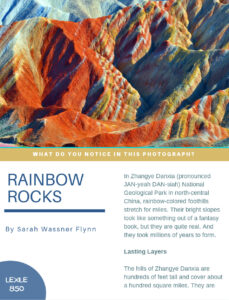It sounds like a silly question if you are a teacher. We know students need to understand what they read, but maybe you haven’t stopped to really think about the question in awhile. It may seem counterintuitive, but just because your students read fluently doesn’t mean they understand what they read. This is a dangerous pitfall, because if we hear a student reading fluently, we often assume they are a good reader.
Assessing reading comprehension is further complicated when students who are able to comprehend fiction passages, may not be comprehend informational texts. Literary passages simply do not require the same set of comprehension skills as informational texts.
This issue of comprehending informational texts was identified in 1993 when researchers found “nearly 44 million American adults cannot extract even a single piece of information from a written text if any inference or background knowledge is required” (Levy, 1993). Not much since 1993 has happened to address the issue. Nearly two-thirds of U.S. fourth graders can only read at or below a basic level according to the 2015 National Assessment of Educational Progress (NAEP) (The Nation’s Report Card, 2015). Researchers have even identified a “fourth grade slump” they attribute to issues with comprehending informational text (Biancarosa & Snow, 2006; Chall & Jacobs, 2003; Sanacore & Palumbo, 2009).
 It is no surprise success in school, career and society depends on a student’s ability to comprehend informational text (Duke 2004). But did you know, increasing a child’s ability to comprehend informational text also increases overall reading achievement (Duke, 2004)? Did you know, reading informational texts increases a child’s background knowledge and background knowledge accounts for as much as 33 percent of the variance in student achievement (Marzano, 2000)? And did you know, a major predictor of overall student achievement is the ability to use comprehension strategies during content area reading (Duke, 2003b; Hall & Sabey, 2007; Vacca et al., 2009)? These are some of the reasons why the writers of the Common Core recommend increasing the instructional time spent with informational text during elementary school from 10% to 50% (Coleman, 2011). Is 50% of your reading instructional time spent with informational texts? Probably not. I know as a fourth grade teacher, I didn’t meet this goal for a variety of reasons including not enough access to informational texts and the inability of students to independently read the texts I did have in my classroom.
It is no surprise success in school, career and society depends on a student’s ability to comprehend informational text (Duke 2004). But did you know, increasing a child’s ability to comprehend informational text also increases overall reading achievement (Duke, 2004)? Did you know, reading informational texts increases a child’s background knowledge and background knowledge accounts for as much as 33 percent of the variance in student achievement (Marzano, 2000)? And did you know, a major predictor of overall student achievement is the ability to use comprehension strategies during content area reading (Duke, 2003b; Hall & Sabey, 2007; Vacca et al., 2009)? These are some of the reasons why the writers of the Common Core recommend increasing the instructional time spent with informational text during elementary school from 10% to 50% (Coleman, 2011). Is 50% of your reading instructional time spent with informational texts? Probably not. I know as a fourth grade teacher, I didn’t meet this goal for a variety of reasons including not enough access to informational texts and the inability of students to independently read the texts I did have in my classroom.
So, what can you do to help your students with informational text comprehension? Not only does comprehending informational text require a different set of strategies for students than when reading fiction, it also requires a different set of strategies for teachers:
- Students need to be proactively taught to identify and understand informational text features first and foremost (Bamford & Kristo, 1998).
- Students benefit from learning multiple comprehension strategies while they are reading (McKeown et al., 2009).
- The more informational texts a student reads, the better their ability to comprehend text (Brenner & Hiebert, 2010).
- Informational texts should be carefully integrated into the curriculum (Strauss, 2010).
- Informational texts should be matched to the student’s reading level (Lennon, C. & Burdick, H., 2004).

Frustrated with the lack of informational text resources, we decided to come up with a new solution based on research to help teachers with informational text instruction. StarrMatica Texts: Science Your Way is a library of customizable informational texts written specifically to address the Next Generation Science Standards. StarrMatica Texts: Science Your Way helps teachers access and integrate informational texts into their curriculum during ELA or science instructional time. Unique to our resource, texts can be adjusted to a student’s individual reading level, so all students can read the same text. Corresponding comprehension instructions are taught throughout the text and Common Core-aligned quiz questions are provided as well.
We are excited about StarrMatica Texts: Science Your Way and will keep you updated on our progress through upcoming blogs. Please visit our website or contact us directly to learn more.

